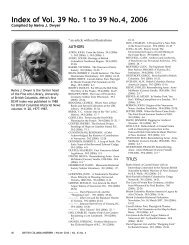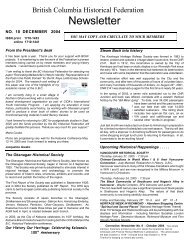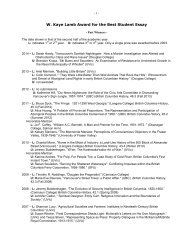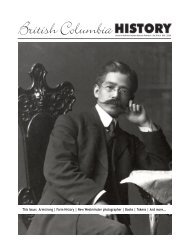bc historic news - BC Historical Federation
bc historic news - BC Historical Federation
bc historic news - BC Historical Federation
Create successful ePaper yourself
Turn your PDF publications into a flip-book with our unique Google optimized e-Paper software.
had an agitator to eliminate the packing tendency ofthe fine powder and was placed on a set of strongsprings to adjust the angle of the floor and maintain aconstant flow towards the outlets and the as thequantity of the calcium arsenate decreased.To facilitate the operation of the flying boatsand allow them to land in any direction, a scow,loaded with at least 7-tons of the calcium arsenate 4packed in 50 lb. sacks for ease of handling and toreduce the chance of packing in the hoppers wasanchored in the middle of the harbour, just east ofBrocton Point adjacent to Stanley Park. The scow,which also carried five drums of aviation fuel forrefueling the aircraft, was towed into position in theearly hours of Sunday, June 15, 1930.Flying operations began precisely at 04: 00hours with three Boeing B1E flying boats under thedirection of Canada Airways Superintendent forWestern Operations, Donald R. MacLaren. MacLarenwas founder of Pacific Airways (1925) and Canada’sfourth highest scoring ace during World War One.Again another footnote was scored for our history:this was the first and probably the only time pureflying boats were ever been used for either forest orcrop “dusting” in Canada.The original intent was to fly the aircraft information, yet it soon became apparent that astaggered line-eastern approach provided a moreideal method, for the trailing pilots could see the dustpattern from the aircraft ahead and adjust their courseaccordingly to achieve the proper coverage. Theinsecticide was released at about 50 feet above thetree top level. With three aircraft working, this timingallowed for a merry-go-round pattern with thepreviously applied dust still visible. Approximately20 flights were required to complete this operation.The dusting of Stanley Park was completed by 8: 45a.m.Operations then moved to the Seymourwatershed above Indian Arm. There, flying was moreproblematic as the target area was approximately 7miles inland and at an elevation of 2, 000 feet. Thecanyon terrain on the hillside also created more airturbulence. Again, approximately 8 tons of calciumarsenate were applied to the forest. To test theeffectiveness and distribution of the near-whitecalcium arsenate dust throughout the forest canopy,dark canvas tarps were randomly placed on theground. The drifting dust penetrated to the lowestlevels, completely covering the underbrush. Morningdew on the Douglas fir needles caused the calciumarsenate to bind to the needles. This unexpected turnenhanced the efficacy of the insecticide whereas onthe shrubs and underbrush below, air movementcaused the dry powder to dislodge, falling to the forestfloor.As a result of the dusting, it was reported thatWestern hemlock looper caterpillars lay on the groundin a two-inch thick carpet in Stanley Park and“pedestrians sank to their ankles and vehicles leftdeep ruts in the green viscid mass.” Subsequently itwas reported: “There’s never been another worm seenor heard of since that time in that area.” Yet on a moresobering thought, other than the fact that close to threetons of highly toxic arsenic oxide were dumped inthe Vancouver City water supply catchment area andon a well-used public park, Hector Richmond, arenowned entomologist with the British ColumbiaForest Service, indicated, that in hindsight: “Thebenefits of this attempted control were questionable.”Vancouver citizens, however, did not complain aboutthe highly toxic dust or the gooey mass of decayingcaterpillars on the ground. Yet, they complained aboutthose “ruddy aircraft” flying around at an ungodlyhour on their Sunday morning!Postscript: There is a subtle difference interminology when dealing with aerial application ofinsecticides. In the early days of the science,insecticides were applied as a dusting powder, hencereferred to as “dusting”; later insecticides wereapplied in emulsions, often as an oily-type spray.Calcium arsenate, or alternatively, lead arsenate, waswidely used in both Canada and the United Statesfor aerial application on forest pests between 1925 and1935 mainly to attack the Spruce bud worm, Catalpaworm, Western hemlock looper and the Gipsy moth.In the southern United States, calcium arsenate wasused extensively against cotton-destroying insects.The infamous insecticide, DDT, was first used in aerialforest spraying in British Columbia in 1946. Again,the Western hemlock looper was the target, but thelocation this time was the Nitinat - Sarvita Rivervalleys adjacent to Pacific Rim National Park. By themid-1950’s it was realized that DDT was extremelydestructive to aquatic life, and particularly deadly onsalmon smolt. The final spraying of DDT (actually, aDDT-Malathion mix) was used on the Douglas firTussock moth in the Okangan Valley in 1962. By 1964,forest pest operations in B.C. switched toPhosphamidon then in the early 1970’s to using a viralcontrol agent to kill the insects. •REFERENCESCanadian Forest Service,Interview with George RalphHopping, August 1972.Corley-Smith, Peter.Barnstorming to Bush Flying:1910 - 1930. Victoria: Sono NisPress, 1989.Corley-Smith, Peter. Bush Flyingto Blind Flying: 1930 - 1940.Victoria: Sono Nis Press, 1993.Dominion of Canada, Departmentof National Defence. [Annual]Reports on Civil Aviation, 1927-1930.Duffy, D., and C. Crane (eds.).The Magnificent Distances: Earlyaviation in British Columbia 1910- 1940. Sound Heritage, Number28. Victoria: Provincial Archivesof British Columbia, 1980.Fortier, Ronald. AgriculturalAviation in Canada: A ShortHistory. Ottawa: AeronauticalCollection, National AviationMuseum, Ottawa, 1997.MacLaren, D. R.” Dusting DefoliatedAreas,” The Bulletin, CanadianAirways Limited, Vol. 3 No. 10, April15, 1932, 2 - 5 &14 - 16.Martin, L. and K. Segrave. CityParks of Canada. Mosaic Press,Oakville ON: Mosaic Press, 1983.Neufeld, David. “The History ofAerial Application: Anintroduction.” The Journal ofthe Canadian Aviation <strong>Historical</strong>Society, Vol. 17 No. 2, (Summer1979), 60 - 61Richmond, Hector. ForestEntomology: From Packhorse toHelicopter. Pest Managementreport Number 8. Victoria: B.C.Ministry of Forests, 1986.Dead trees in StanleyPark.(opposite page)<strong>BC</strong> Archives photo NA04267BRITISH COLUMBIA HISTORY - Vol. 39 No. 1 3







